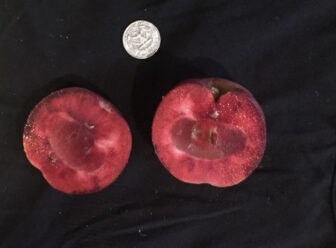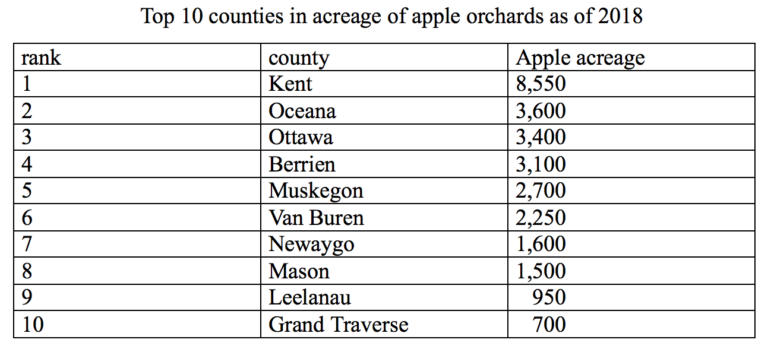By KYLE DAVIDSON
Capital News Service
LANSING — The Michigan Craft Beverage Council has awarded $34,644 to study how to produce new varieties of apples for cider-making.
The council is underwriting the study led by Steve van Nocker, a professor in Michigan State University’s Department of Horticulture, who started the project about 15 years ago.
Van Nocker’s long-term goal is to develop an apple that can be used for juice and extracts.
By targeting characteristics like red juice and flesh and resistance to disease and harsh climate, his research could diversify Michigan apples.
While some companies are interested in red-fleshed apples for fresh market sales, the real economic potential lies in beverage-making, van Nocker said.

Steve Van Nocker
Michigan State University professor Steve Van Nocker is producing a disease-resistant, red-fleshed line of apples.The juice from red-fleshed apples would be great for sports drinks, novelty juices and health food products, he said. The dark, bitter juice could also be sold for direct consumption.
The council is an arm of the Department of Agriculture and Rural Development and advises the department on behalf of industry.
Its director, Jenelle Jagmin, said the council saw potential for Michigan’s hard cider industry in van Nocker’s proposal.
It’s one of nine grants worth more than $274,000 awarded this year to “support research into agricultural inputs of craft beer, spirits, wine and hard cider.” The council selected the projects from 17 applications.
New ingredients and beverage varieties help set the Michigan craft beverage industry apart, experts say.
“Anytime we can get our hands on a new, weird apple, we try to go for it,” said Tony Hansen, the chief information officer for Short’s Brewing Co. The company has a production facility in Elk Rapids and a pub in Bellaire.
The red juice apples have been a hit among Michigan cider makers.
In 2016, Starcut Ciders, a division of Short’s, developed a dark red cider using Otterson apples, one of van Nocker’s parent varieties. To make “Flamingo Juice,” Ottersons were used heavily to capture how future blends might taste, Hansen said.
The red juice can also create rosé hard ciders, which have gained popularity in recent years.
“I feel like everyone is making a rosé now,” he said.
While van Nocker’s research has opened positive horizons for researchers and beverage makers, it could also benefit apple growers.
Michigan’s cider industry holds stronger ties to agriculture than other craft beverage categories, said John Behrens, the president of the Michigan Cider Association and the founder of Farmhaus Cider Co. in Hudsonville.

National Agricultural Statistics Service
Ten counties with the most acres of apple orchard.“There’s a lot of great breweries and a lot of great wineries here. Some of those breweries for example, are using some Michigan hops, but a lot of them aren’t,” he said. “Same thing with wineries, a lot of them are using Michigan grown grapes, but some of them aren’t.
“When it comes to cider, it is really all Michigan-grown apples,” Behrens said.
One challenge with producing cider is the higher cost at early stages. “With beer, you’re starting with water. With cider, you’re starting with fruit,” he said.
The cost and availability of fruit varies year to year, Behrens said, and sugar levels in the fruit can also vary.
There are also concerns about diseases like fire blight and scab. While van Nocker’s pre-brgoo
eeding line resists those diseases, there are still worries about losing crops because of climate.
Warm early springs promote floral development, van Nocker said. Then late spring frosts can damage the flowers and reduce the apple yield. Such damage can be avoided by introducing lines that are extremely late blooming.
Van Nocker’s prebreeding line has shown results in color, production and disease resistance.
Size remains a limiting factor, however, because the apples are too small for most modern cider-making equipment. As a result, apples can bounce out or be crushed by rollers while being washed and processed.
Van Nocker will continue crossing different varieties of apples in pursuit of the desired traits.
If he gets something he’s happy with, he’ll test grow it in at least three other locations. The process could take about five years before he recommends the fruit to growers.
After that, more trees will be grown to meet demand.
Kyle Davidson reports for Great Lakes Echo.